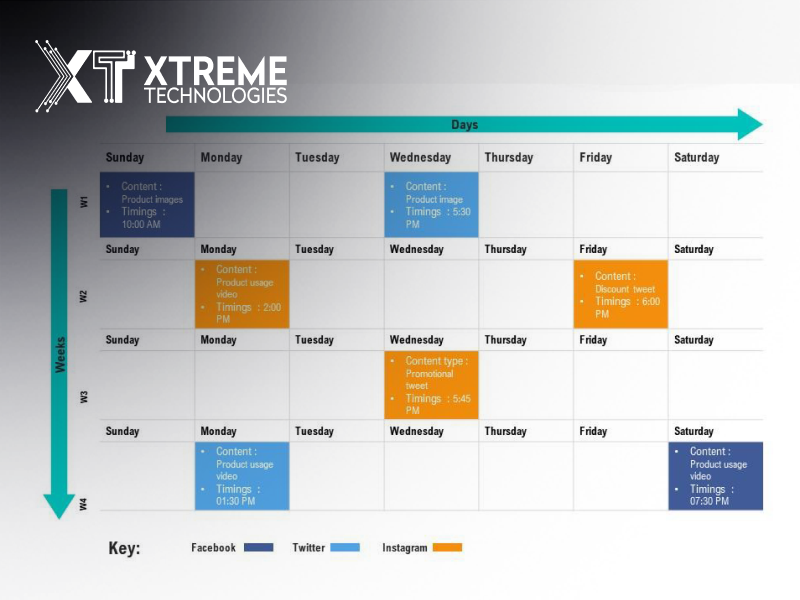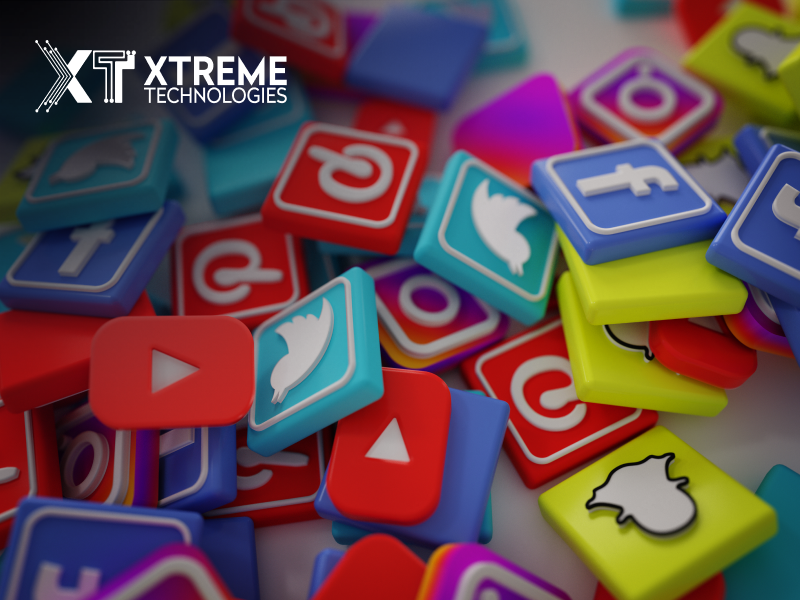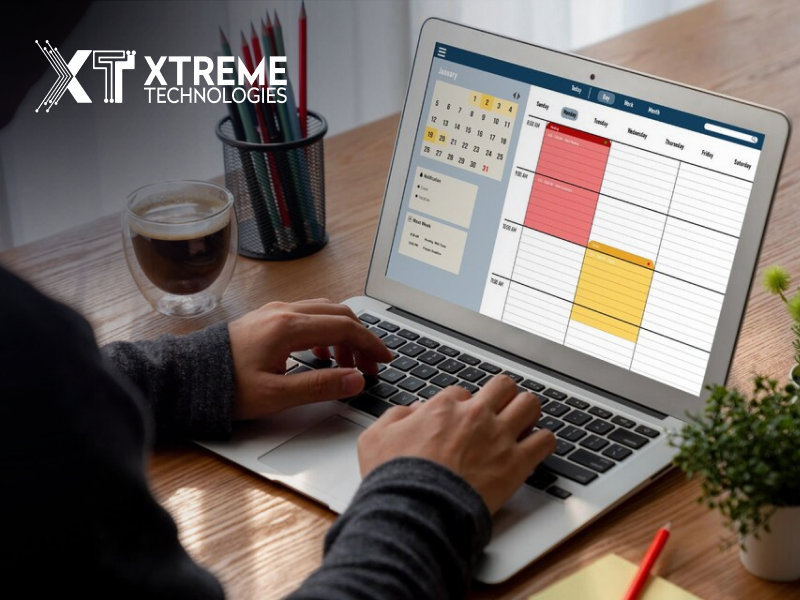
Social Media Marketing Success: Creating the Perfect Marketing Calendar
Digital Marketing, Marketing, Social Media,
Published on: October 30, 2023
Contents
hide
In the vast digital expanse of the 21st century, where social media platforms reign supreme, successful communication is about precision, timeliness, and strategy. Enter the social media marketing calendar: an indispensable tool for brands, marketers, and businesses aiming to make their mark online.
What is a Social Media Marketing Calendar?
 A social media marketing calendar is a visual and strategic tool used by businesses to plan, coordinate, and schedule their social media content. Think of it as a roadmap for all social media activities, outlining what to post, when to post it, and on which platform. This calendar assists in organizing content, tracking deadlines, and ensuring that the brand’s messaging is consistent across all platforms.
A social media marketing calendar is a visual and strategic tool used by businesses to plan, coordinate, and schedule their social media content. Think of it as a roadmap for all social media activities, outlining what to post, when to post it, and on which platform. This calendar assists in organizing content, tracking deadlines, and ensuring that the brand’s messaging is consistent across all platforms.
The Importance of Social Media Marketing Calendar
Organization
The digital world moves at an astonishing pace. With several platforms to manage, from Facebook to TikTok, it's easy for businesses to become overwhelmed. A calendar brings order to this chaos, ensuring that every post, tweet, or story is pre-planned and executed flawlessly.Consistency
Brands need a consistent voice and frequency in their posts to maintain visibility and engagement. A calendar ensures that content is distributed evenly and that the brand remains top-of-mind for its audience.Strategy Over Spontaneity
While impromptu posts can occasionally bring value, a brand’s social media presence should be more strategic than spontaneous. Planning ahead with a calendar allows businesses to align their social media initiatives with broader marketing objectives, seasonal events, or industry trends.Time Management
Pre-planning content can save businesses a significant amount of time in the long run. Rather than scrambling to find content to post daily, teams can batch-produce content, allocate resources efficiently, and automate postings.Analysis & Improvement
With a clear record of what content was posted and when, brands can more easily analyze the performance of their posts. This makes it simpler to tweak social media strategies, optimize posting times, or shift focus between platforms.Benefits of Social Media Marketing Calendar
In an era of digital dynamism, where the online ecosystem is continually evolving, the art of social media marketing demands more than just spontaneous creativity. It requires rigorous planning, strategic coherence, and timely execution. A social media marketing calendar emerges as the fulcrum of this planning process, and its benefits are manifold.
Maintain Consistency in Posting
Every social media platform has specific times when user engagement is at its peak. A calendar helps brands capitalize on these windows. By scheduling posts in advance for these optimum times, brands can ensure maximum visibility and engagement, thus boosting the return on investment for their content.Perfect Timing for Every Post
The Social Media Marketing Calendar isn't just about organizing what to post, but also when to post. Each social media platform has specific times when its users are most active. By scheduling posts during these peak times, brands can ensure that their content is seen by the maximum number of people, increasing the chances of likes, shares, and comments. A well-planned calendar can help businesses cater to multiple time zones, ensuring consistent engagement across the globe.Centralized Content Planning
In the absence of a structured plan, brands can fall into the trap of erratic posting — content that seems disjointed or irrelevant. A calendar ensures that every post, whether it's a tweet, a story, or a status update, fits into a broader narrative or theme. By mapping out content in advance, brands can weave a coherent and compelling story over time, deepening audience engagement.Avoiding costly mistakes
Avoiding costly mistakes is one of the primary reasons brands and businesses invest time and resources into creating and maintaining a Social Media Marketing Calendar. Key dates, be they industry-specific events, holidays, or promotional periods, offer golden opportunities for engagement and sales. A social media calendar ensures you're always prepared for these crucial periods. Repetitive content can be a turn-off for followers. A visual representation of your planned posts, like a calendar, allows you to spot and rectify any unintentional duplication. A calendar ensures a balanced content distribution.Enhance cross-functional visibility
Enhancing cross-functional visibility in a Social Media Marketing Calendar is crucial for aligning different departments or teams within an organization, ensuring seamless communication, and fostering collaboration. Use a universally accessible digital platform like Trello, Asana, or Monday.com. These tools allow teams from different departments to view, edit, and comment on the calendar in real-time. Assign and define roles for different team members. Everyone should be able to view the calendar. Schedule regular meetings with representatives from all involved departments to review the calendar. This promotes knowledge sharing, feedback collection, and alignment of objectives.Creating and Managing a Social Media Marketing Calendar
With the ever-growing importance of social media as a platform for brands to connect with their audience, the need for a systematic approach to content posting is evident. A Social Media Marketing Calendar acts as the backbone of this strategy. Here’s a step-by-step guide to creating and managing one effectively.
Identify Your Social Media Channels
Understanding when your target audience is most active and receptive is crucial. Research the optimal times for each social media channels and tailor your calendar accordingly. Not all social media platforms will be suitable for your brand or objectives. Focus on those where your target audience is most active and where your content aligns best with the platform’s format.Conducting a Comprehensive Social Platform Audit
Conducting a comprehensive social platform audit within the context of a Social Media Marketing Calendar allows businesses to evaluate the effectiveness of their current social media strategies and make informed adjustments. Begin by listing all your brand's official social media accounts. Ensure there are no unauthorized or redundant accounts operating in the name of your brand. Check if your logo, banner images, bios, and other branding elements are consistent across all platforms. They should be up-to-date and aligned with your current brand guidelines. Using your Social Media Marketing Calendar, review how frequently you post on each platform. Compare this frequency with engagement metrics to identify any correlations.Define Tracking Metrics for Your Calendar
Defining tracking metrics for your Social Media Marketing Calendar is crucial for gauging the effectiveness of your social media campaigns and content strategies. Before you can choose your metrics, be clear about your objectives. Are you looking to increase brand awareness, drive traffic to your website, increase sales, or boost audience engagement? Your goals will dictate which metrics are most relevant. Reactions Indicates basic audience interaction with your content. Shares and reposts reflect content resonance as users share it in their circles. Comments highlight deeper engagement and often provide qualitative insights. Clicks track how often users click on your content, company name, or logo.Crafting an effective posting schedule
Crafting an effective posting schedule for your Social Media Marketing Calendar is a blend of strategic insight, data analysis, and a touch of experimentation. Demographics know the age, location, gender, and other demographics of your followers. Behavior use analytics to understand when your audience is most active online. Look at your best-performing posts. When were they posted? Identify patterns and leverage this data to inform your future schedule. If your audience is global, you'll need to post at times that cater to various key time zones, or consider segmenting your content to target different regions at optimal times.Establish a Content Review Schedule
Establishing a content review schedule for your Social Media Marketing Calendar ensures that all content aligns with brand guidelines, is error-free, and resonates with your target audience. The review procedure contributes to uniformity and high quality. Decide whether you'll review content daily, weekly, bi-weekly, or monthly. Different content types may require different review processes. For example, blog articles might need a detailed review for accuracy and depth, while tweets may focus on brevity and engagement. Google Workspace can help streamline the review process, allowing team members to leave comments, make edits, and approve content.Monitoring and Analyzing Publish Content
Your social media calendar is more than simply a tool for planning. In addition, it gives you a tool to analyze and evaluate KPIs across all of your platforms. Analyze the data you obtain from your social media campaigns, and then keep improving the efficiency of your social media schedule. You can keep track of content that might need to be optimized or repurposed if you attach postings to particular campaigns. When a piece of content works well, store it or make a note to reintroduce it later when you need to reassess your strategy or come up with ideas for new pieces.The Social Media Marketing Calendar Checklist
Complete a Social Platform Audit across all platforms
Completing a social platform audit across all platforms is pivotal for understanding your brand's online presence, gauging its effectiveness, and identifying areas of improvement. List all official brand profiles on platforms like Facebook, Twitter, LinkedIn, YouTube, and others relevant to your brand. Check for any unofficial or rogue accounts. You should report any impersonations or unauthorized accounts. Ensure consistent profile photos (usually the brand logo), cover images, and bios across platforms. Ensure contact information, website links, and other details are up-to-date and uniform. Measure key performance indicators like follower count, engagement rates, click-through rates, and conversion rates. Evaluate audience demographics across platforms to understand your reach.
Ensure consistent profile photos (usually the brand logo), cover images, and bios across platforms. Ensure contact information, website links, and other details are up-to-date and uniform. Measure key performance indicators like follower count, engagement rates, click-through rates, and conversion rates. Evaluate audience demographics across platforms to understand your reach.
Pick-up 2 to 3 Social Platforms You Will Use
The choice of social platforms greatly depends on the target audience, type of content, and goals of the brand or individual. However, let's consider three of the most popular and versatile platforms:Choice your social media content format and post type
The choice of content format and post type depends on the target audience, objectives, and the social media platform in question. Ensure there's a balance of:- Educational Content: Tutorials, articles, infographics.
- Engagement Content: Polls, questions, interactive posts.
- Promotional Content: Product launches, offers, sales pitches.
- User-Generated Content: Shares, testimonials, reviews.
- Mark down significant dates – holidays, events, product launches, or any other dates crucial for your brand. Planning around these ensures you leverage timely opportunities.
Create Social Media Temples, Lazy Hashtag and Lazy Copy
Identify which hashtags associated with your brand perform the best. Check if you’re using too many, too few, or irrelevant hashtags.Fill your Social Media Holidays, Events and Campaign
Evaluate the performance of paid ads across platforms. Analyze metrics like return on ad spend (ROAS), conversion rates, and cost per click. Certainly, integrating holidays, notable events, and campaigns into your social media calendar can amplify engagement and relevance. It's vital to ensure the content is tailored to your audience and remains genuine to your brand's voice and values.Determined a Social Media Posting Schedule
Research and identify the optimal times to post on each social media platform based on your audience's activity. Schedule posts accordingly to maximize visibility and engagement. Determine if you’re posting too often or too infrequently on each platform. Compare the frequency against engagement rates to see if there's a correlation.Monitor your Social Media Posts Success
Monitoring the success of your social media posts is essential to gauge the effectiveness of your content, refine your strategies, and ensure you're meeting your objectives. Begin by setting clear, measurable goals for your social media activities. Whether you aim to increase brand awareness, drive website traffic, or generate leads, having precise objectives will guide your monitoring efforts. Choose key performance indicators (KPIs). Utilize built-in analytics tools. Most social media platforms offer native analytics. Platforms like Hootsuite, Buffer, or Sprout Social offer comprehensive analytics and can combine data from various social platforms, giving a holistic view of performance.Crafting An Amazing Social Media Content Calendar
Creating an effective social media content calendar requires a blend of strategy, creativity, and organization. Here's a step-by-step guide to crafting a content calendar that'll help you stay consistent, engage your audience, and grow your online presence.
Define Your Goals
- Brand awareness
- Increase website traffic
- Drive sales or leads
- Engagement
- Community building
Audit Your Audience
- Who are they?
- What's their age, location, interests?
- When are they most active online?
- What content do they engage with the most?
Choose Your Platforms
- Focus on platforms where your audience hangs out.
- Each platform might require different types of content.
Content Categories
- News/Updates
- Educational posts
- Behind-the-scenes
- User-generated content
- Promotions/Offers
- Interactive content (polls, quizzes)
- Inspirational quotes or stories
Celebrations and holidays
- Establish Posting Frequency
- Consistency is key, but don't sacrifice quality for quantity.
- Consider the platform: daily on Twitter, 3 times a week on Facebook, daily on Instagram, etc.
Tips to Make your Social Media Post Pop

Find Your Style
Narrative Arcs:
Every post should tell a story. Begin with a hook, develop middle, and conclude with a memorable end or call-to-action.Personal Connection:
Personal stories or behind-the-scenes moments can foster a deeper connection between a brand and its audience.Rule of Thirds:
This classic photography principle involves dividing your image using 2 horizontal and 2 vertical lines, then positioning the important elements along those lines or at their intersections.Color Psychology:
Different colors evoke different emotions. Brands often choose colors strategically based on their target audience's reactions.Recycle Your Post
Revitalizing and recycling your old social media content can breathe new life into posts that once resonated with your audience. Revisit a past event or narrative but from a new perspective or with updated insights. Convert an old blog post into a captivating infographic, or turn a popular image post into a short video or GIF.Be Consistent
You can schedule your postings and time them, but consistency is still required. Be timely with your posting. Work inside your own or the desired time zone. Show that you are online frequently and return messages as soon as you can.Make Use of Every Tools in the Platforms Arsenal
Making your recycled content pop doesn’t just rely on the creativity of the post itself but also on maximizing the features and tools provided by the social media platforms. Instagram, Facebook and Twitter are the powerful tools. YouTube is video content tool. You can consider creating a shorter, more dynamic version using YouTube Shorts.
Keep Up with Trends
Jump onto relevant trends or challenges that fit your brand. Being timely can make your posts feel more relevant.Engaged With Audience
Everyone is aware of the profiles we now overlook. People spread uninteresting, uninteresting, dreary, and self-serving information. The public ultimately loses interest and consciously begins to ignore these pages and profiles. Be engaged. Share fascinating information with your audience that has nothing to do with your brand or you in order to hold their attention. Get responses to your postings by asking questions. Your article will receive more organic exposure in people's timelines the more involvement you receive.Social Media Content Calendar Tools
In the ever-evolving world of social media, staying organized is crucial for success. Social media content calendar tools have become indispensable assets for professionals and businesses looking to maintain a consistent and impactful online presence.
Hootsuite:
One of the pioneers in social media management, Hootsuite allows users to schedule posts, interact with their audience, and get the analytics they need. Its calendar view is intuitive and offers a bird's-eye view of your content strategy for various platforms.Buffer:
Renowned for its simplicity, Buffer provides a straightforward platform for scheduling posts, tracking performance, and managing accounts. The calendar view lets users see their scheduled content and make any necessary adjustments seamlessly.Sprout Social:
Beyond just content scheduling, Sprout Social provides in-depth analytics, engagement tools, and even listening capabilities. The calendar interface is visually pleasing and functional, ensuring users can quickly get an overview of their content landscape.CoSchedule:
Tailored for content marketers and bloggers, CoSchedule not only manages social media content but also integrates with WordPress, allowing you to schedule blog posts and social media promotions in tandem. Its color-coded calendar provides a clear view of your entire content strategy.Trello:
While not specifically designed for social media, Trello's flexible board-and-card system can be easily adapted for content calendars. By creating a board for your social media calendar and cards for each post, users can add details, attachments, and collaborate with team members.Agorapulse:
A comprehensive social media management tool, Agorapulse not only offers scheduling but also social listening, reporting, and team collaboration features. Its calendar module lets you publish, reschedule, and get a glimpse of your content distribution across different platforms.Story Chief's:
With Story Chief's robust yet user-friendly scheduling tool, you can step up your content marketing game. The software may publish your blog pieces on WordPress, Medium, and Blogger in addition to Facebook, Instagram, LinkedIn, and Twitter. A thousand first-party connectors are available on StoryChief's calendar which increases the effectiveness of your social media scheduling. This entails that you can simply manage all of your accounts in a single location and even collaborate in real-time with other team members to gain input and approvals prior to anything being publicEvernote:
Evernote is essentially a note-taking program created to assist users in organizing their tasks and projects as well as capturing thoughts. You may utilize the tools in Evernote to build your own simple content calendar and collaborate with others on it using the Teams features.Frequently Asked Questions
What is Social Media Calendar?
A social media calendar is a detailed overview of your upcoming social media posts, organized by date and time. It can take the form of a document, spreadsheet, or interactive dashboard. Social marketers use content calendars to plan posts, manage campaigns, and review ongoing strategies.Why It is Necessary to have Media Content Calendar?
A content calendar is important to keep your content marketing well-organized and on track. It helps you with initial brainstorming, which saves you from last-minute disastrous planning and helps you produce content consistently.Why is It Important to Create a Monthly Calendar for your Business?
They are powerful branding and advertising tools. By creating a calendar personalized to your business and what it offers, you can consistently place your brand in front of customers and prospects daily, building loyalty, awareness, and recognition.Why It is Necessary to Keep your Business Profile Active?
A social media content calendar allows your business to organize upcoming social media posts into a publishing schedule by date—allowing you to keep track of deadlines and better manage your content creation team.How Social Media Content Affect the Purchasing Decision of Consumer?
Social media is a strong influencer in the world of e-commerce. Shares and recommendations of products or services help increase brand recognition, improve buyer trust, and drive sales. According to Hubspot, 71% of consumers are more likely to make a purchase based on a social media reference.What is the Simple Campaign for Discount and Promotion Posted on Social Media?
Grow sales and market share: use coupons, discount codes, referral contest. Get customer feedback & insights: use vote promotion. Grow followers: run sweepstakes, coupon promotions, and #promotions. Get customers to generate content: run contests and quizzes, # promotions.What are the Things to Consider when Asking a Question on Social Media?
When asking questions on social media, you want your followers to actually take the time to answer you, so stick to questions that are:- Timely - These revolve around a current trend, seasonal event or a hot topic.
- Open - These promote open-ended discussion (yes/no is not enough for an answer).
What kind of Tips and Tricks Can you Share on Social Media?
Here are eight tips that will help you enhance your appearance on various social media.- Check the current trends.
- Use multimedia.
- Be regularly active.
- Pay attention to customer service.
- Don't forget to audit results.
- Interact with your audience.
- Keep promoting your social media accounts.
- Maintain with right tools.







Recent Comments